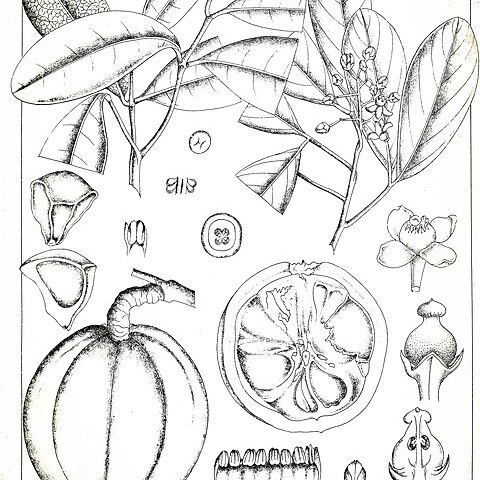Tree 6–18(–30, Watson) m, with small buttresses and many pointed pneumato-phores; bole usually solitary, to 70(–210, Watson) cm diam. Bark rough with longi-tudinal fissures, falling as oblong flakes. Leaf rachis and petiole to 10 cm, sometimes with persistent apical spike to 1 mm. Leaflets in (1) 2 or 3 (4) pairs, (5–)7–10(–17) by (2.5–)4–6.5(–7) cm, elliptic-oblong or lanceolate to oblanceolate, base cuneate, ± asym-metric, apex acute to obtuse, venation prominent on both surfaces in sicco; petiolule (0–) 2–5 mm, sometimes swollen. Thyrses 3–8(–13) cm long, often produced with the new leaves, ± lax, main axis clear; lateral branches to 4 cm; bracts and bracteoles 0.5 mm, ± persistent; pedicels 3–8 mm, not conspicuously swollen near calyx. Calyx lobes 1–1.7 mm long. Petals 3.5–4 by 2–3 mm, oblong to obovate, creamy white. Staminal tube 2–3 mm diam., lobes acute to apiculate or bifid to retuse. Fruit 6–11 cm diam., flattened-globose. Seeds 5–10, 4–6.5 cm long. First leaves simple.
Tree 3–15 m. tall; bark rough.. Ribbon-like pneumatophores absent.. Leaves up to 16 cm. long, glabrous drying yellowish green; leaflets 2–6, subcoriaceous, ovate or ovate-lanceolate, up to 12 × 6 cm., tapering from near the asymmetric obtuse or subtruncate base to the subacuminate apex.. Inflorescence 5–15 cm. long, when well developed a lax raceme of lax cymes.. Calyx ± 0.2 cm. long, glabrous.. Petals up to 0.7 cm. long, glabrous.. Staminal tube up to 0.55 cm. long, glabrous.. Fruit up to 8 cm. in diameter, otherwise similar to X. granatum.. Seeds 3.5–7.5 cm. long.. Fig 21/6.
Leaves paripinnate, drying yellow-green, petiole and rhachis up to 16 cm. long, glabrous; leaflets up to 12 × 6 cm., opposite, 2–3 (4)-jugate, ovate or ovate-lanceolate, tapering from near the base to a subacuminate apex, base variable, asymmetric, glabrous, subcoriaceous, venation closer and less prominent than in X. granatum.
Medium-sized much-branched spreading semi-evergreen tree up to 13 m. tall (much taller elsewhere), sometimes flowering as a shrub; bark rough like an Ulmus; ribbon-like buttresses absent.
A small tree. It grows 5-18 m tall. It can be 30 m tall and have a trunk 70 cm across. The flowers are creamy-white. The fruit are round and 11 cm across.
Flowers white or greenish-white in lax racemes or panicles of 3–7-flowered cymes; peduncle plus rhachis 5–14 cm. long; bracts minute, usually caducous.
Calyx c. 2 mm. long, glabrous, lobed to beyond the middle, the lobes of irregular outline, often apiculate.
Ovary less than 1 mm. in diam., style 1 mm. long; disk situated beneath ovary.
Fruit up to 8 cm. in diam., obscurely 4-sulcate.
Staminal tube 4–5·5 mm. long, glabrous.
Petals up to 7 × 4 mm., glabrous.
Seeds 3·6–7 cm. long.


